Authors Declaration Statement Samples
-
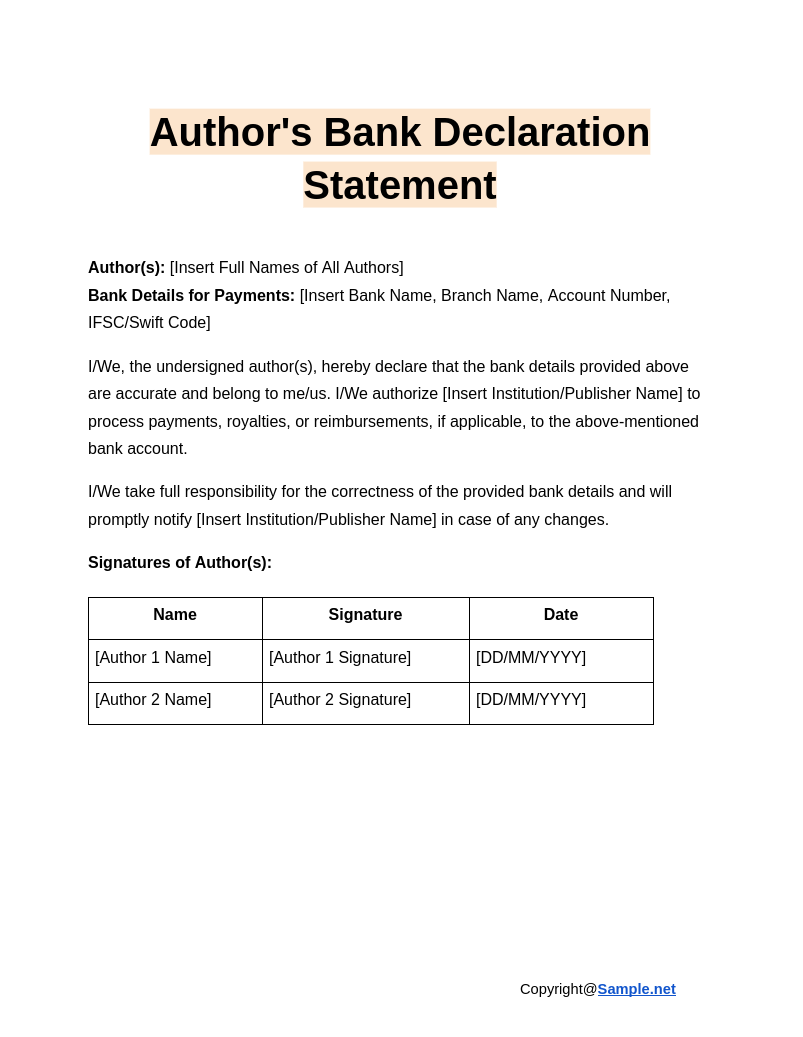
Author’s Bank Declaration Statement
download now -
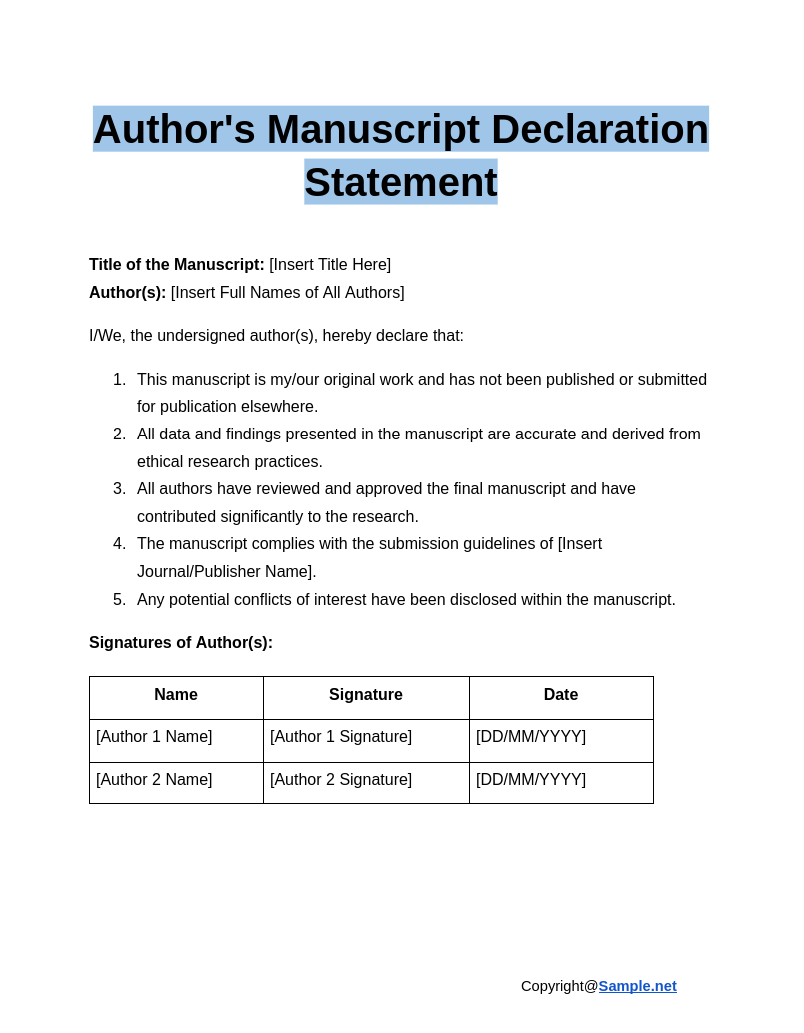
Author’s Manuscript Declaration Statement
download now -
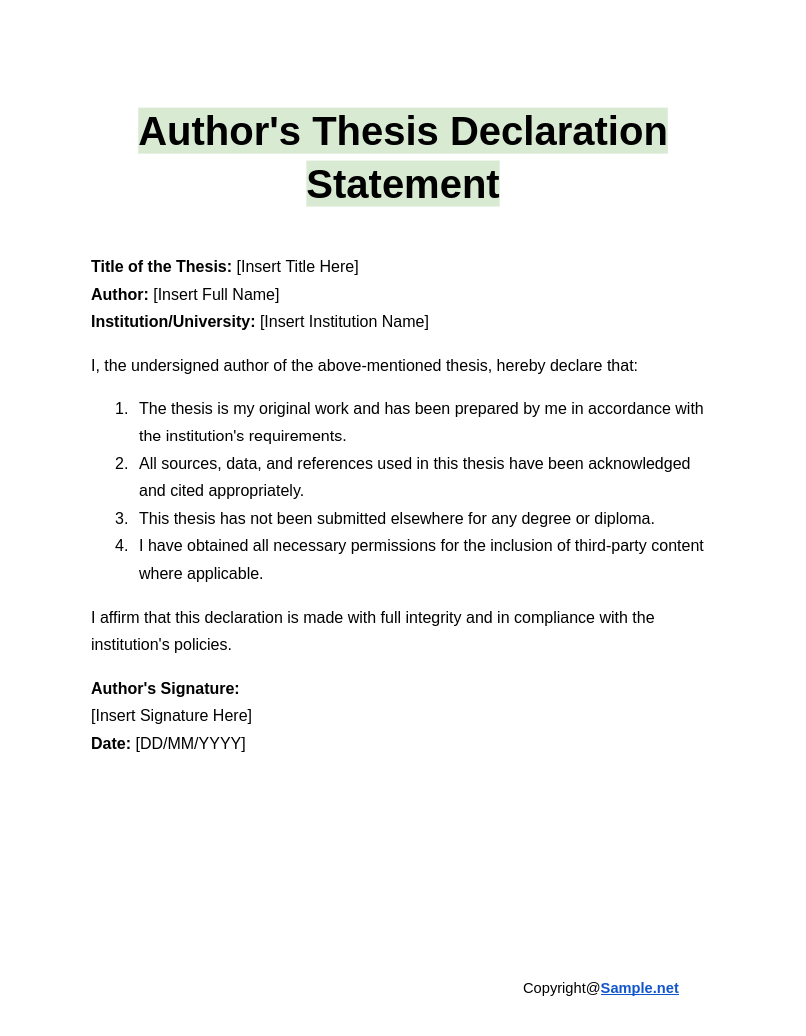
Author’s Thesis Declaration Statement
download now -
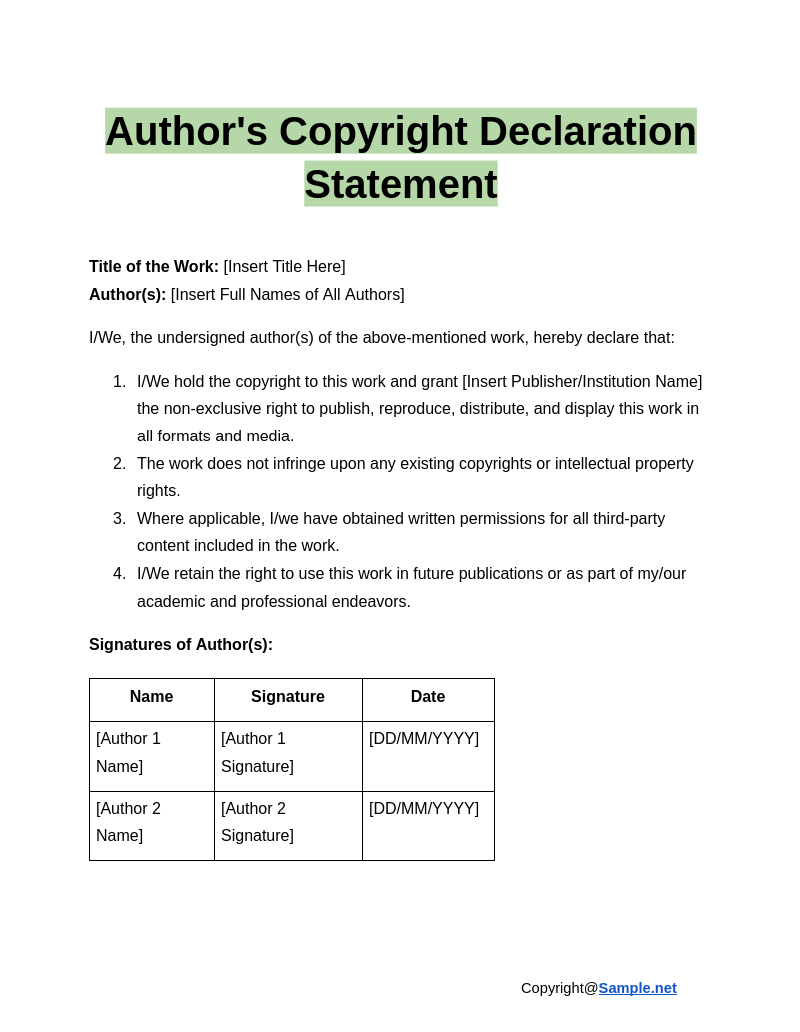
Author’s Copyright Declaration Statement
download now -
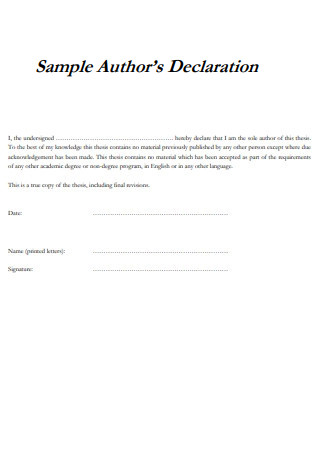
Authors Declaration Statement
download now -

Printable Authors Declaration Statement
download now -
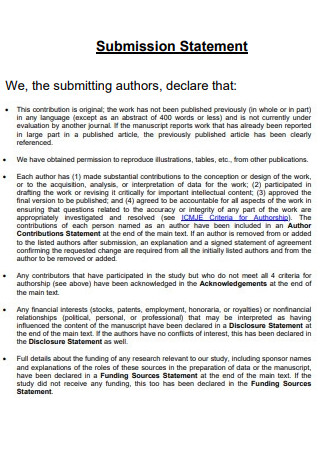
Authors Submission And Declaration Statement
download now -
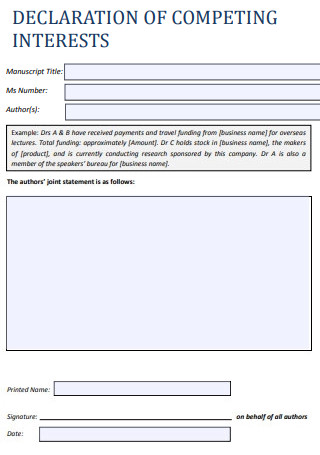
Authors Interest Declaration Statement Form
download now -
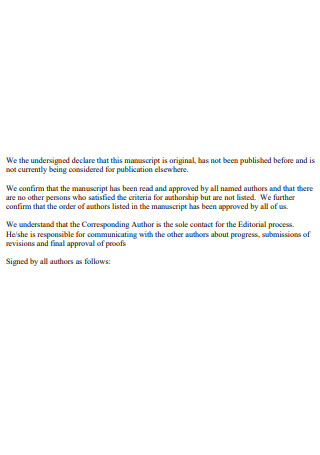
Authors Declaration Statement Format
download now -
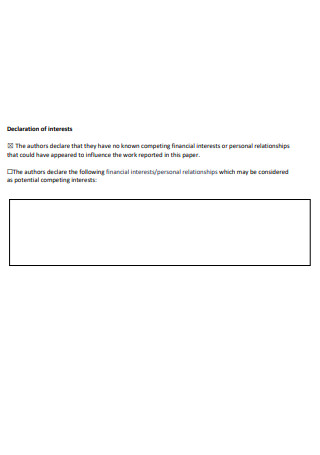
Professional Authors Declaration Statement
download now
FREE Authors Declaration Statement s to Download
Authors Declaration Statement Format
Authors Declaration Statement Samples
What is an Authors Declaration Statement?
Purpose of the Author’s Declaration Statement
How to Write an Authors Declaration Statement
FAQs
What is the procedure for making a declaration?
Why does authorship matter?
What about contributors who aren’t authors?
What happens if an Author’s Declaration Statement is not included?
What is the role of conflicts of interest in this statement?
How is authorship determined for collaborative work?
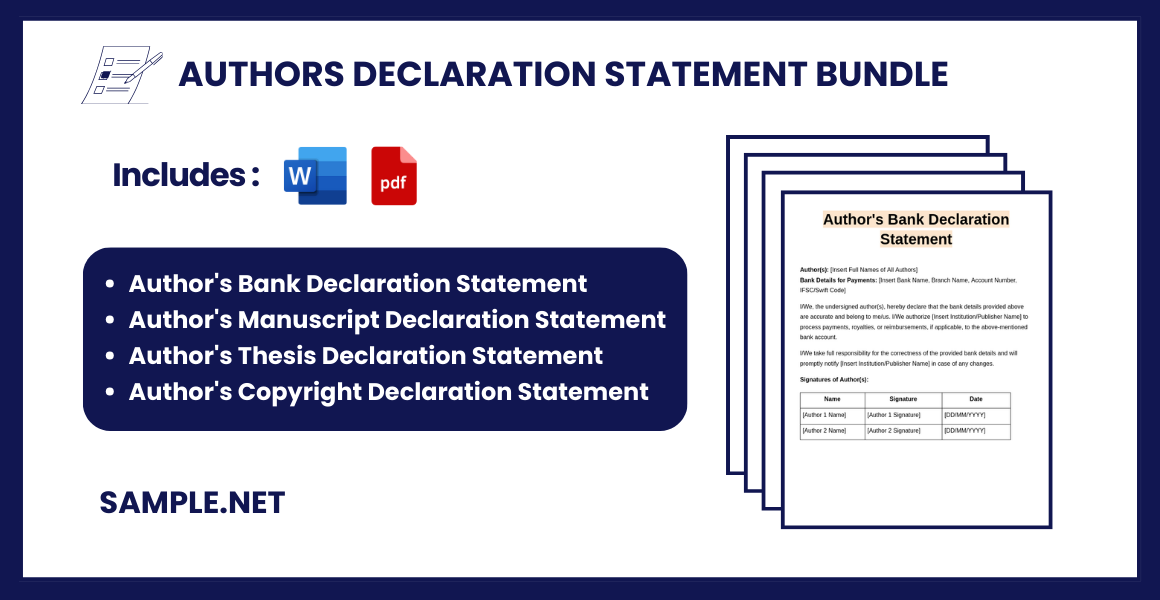
Download Author's Declaration Statement Bundle
Authors Declaration Statement Format
Title of the Work: [Insert Title Here]
Author(s): [Insert Full Names of All Authors]
I/We, the undersigned author(s) of the above-mentioned work, hereby declare that:
- The work submitted is my/our original creation and has not been previously published or submitted elsewhere for consideration.
- I/We have conducted the research and prepared the manuscript ethically and in accordance with all relevant institutional and journal guidelines.
- All sources, data, and references used in the creation of this work have been appropriately cited and acknowledged.
- There are no conflicts of interest, financial or otherwise, related to this work, or all potential conflicts have been disclosed in the manuscript.
- All authors have contributed significantly to the research and preparation of this work and have approved the final version of the manuscript for submission.
- The submission complies with all copyright and intellectual property requirements, and I/we affirm that the work does not infringe on the rights of others.
I/We take full responsibility for the integrity and accuracy of the work submitted.
Signatures of Author(s):
| Name | Signature | Date |
|---|---|---|
| [Author 1 Name] | [Author 1 Signature] | [DD/MM/YYYY] |
| [Author 2 Name] | [Author 2 Signature] | [DD/MM/YYYY] |
| [Author 3 Name] | [Author 3 Signature] | [DD/MM/YYYY] |
What is an Authors Declaration Statement?
An Author’s Declaration Statement is a written confirmation by an author(s) stating that their work is original, unpublished, and adheres to ethical publishing practices. It assures that the authors have followed required guidelines, disclosed conflicts of interest, and taken full responsibility for the content’s accuracy and credibility. This document protects intellectual property rights and maintains academic honesty in research and publications. You can also see more on Self-Declaration.
Purpose of the Author’s Declaration Statement
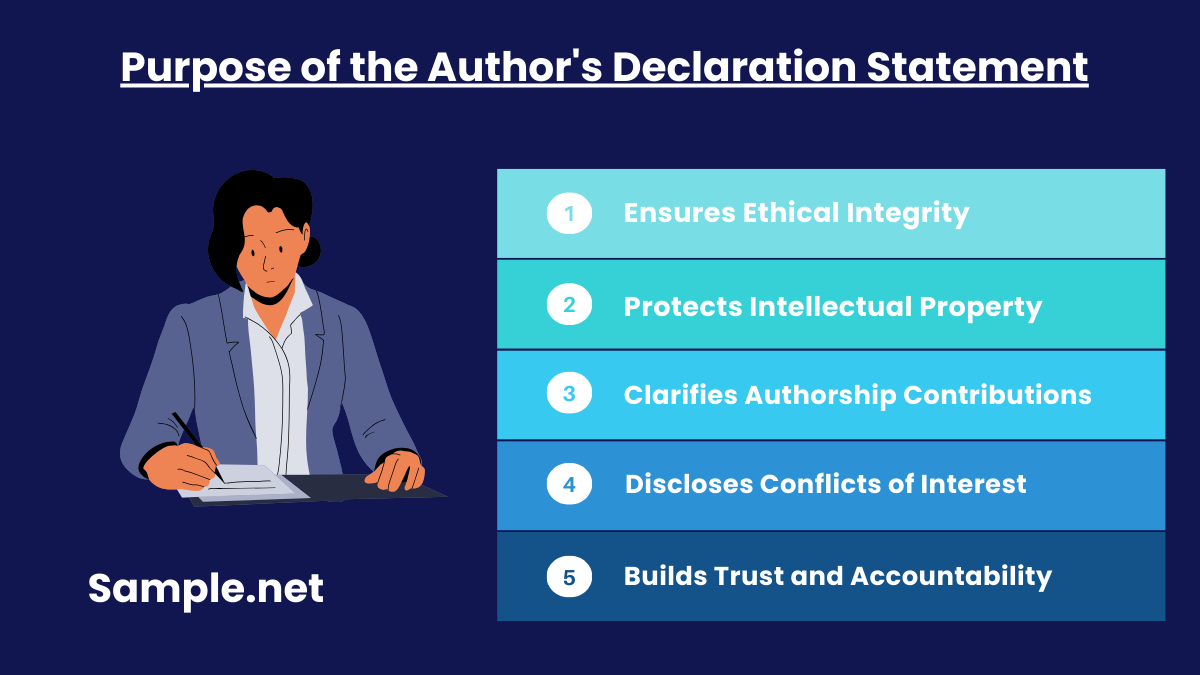
1. Ensures Ethical Integrity
The Author’s Declaration Statement acts as a formal commitment by the authors to uphold the highest standards of ethical publishing. By affirming that the submitted work is original, free from plagiarism, and compliant with ethical guidelines, it safeguards the integrity of the research or creative content. This process not only protects the authors but also preserves the credibility of academic and publishing institutions.
2. Protects Intellectual Property
This statement serves as a critical tool in protecting the authors’ intellectual property rights. By formally declaring the originality of their work, authors prevent unauthorized use, duplication, or misrepresentation by others. It also ensures that the work receives rightful acknowledgment, fostering respect for the creator’s contributions in academic and professional domains. You can also see more on Declaration Form.
3. Clarifies Authorship Contributions
In collaborative works, the statement eliminates ambiguity by clearly defining the role and contributions of each author. Whether it’s conceptualizing the study, conducting research, analyzing data, or writing the manuscript, this clarity ensures fairness and transparency. It also prevents future conflicts or disputes over authorship credit, fostering a harmonious research environment.
4. Discloses Conflicts of Interest
The statement brings transparency to potential conflicts of interest, such as financial ties, sponsorships, or personal relationships that could bias the research or its outcomes. By openly disclosing such conflicts, the authors build trust with publishers and readers while ensuring that the research remains unbiased and credible.
5. Builds Trust and Accountability
A robust declaration statement demonstrates the authors’ commitment to accuracy, ethical compliance, and high-quality work. By accepting full responsibility for the content, authors foster trust with publishers, reviewers, and readers. This trust is essential for the publication’s success and ensures a positive reputation for all parties involved in the publishing process. You can also see more on Submission Forms.
How to Write an Authors Declaration Statement

Since this article has defined what an author’s declaration statement is and has defined the author’s declare no conflict of interest, then you are ready to proceed to write your statement. As an author, it is not easy to concisely store all the information relevant to the responsibilities of the involved co-authors of the written document in one clear statement. So with this guide, you will be able to know how to go about filling the statement. If you prefer to see the structure for yourself, proceed to view the author’s declaration statement sample provided.
Step 1: State Corresponding Author
The matching author’s name, address, and valid email address. The corresponding author is the person in charge of the article as it progresses through the submission procedure at the journal. All contact relevant to the manuscript will be forwarded to this individual via the system, thus they must be registered with the editorial manager. The corresponding author is responsible for any manuscript amendments and is the sole author who can see the document’s progress as it progresses from one stage to the next. They are the solely authorized contact with the editorial office and are responsible for communicating with the other writers about progress, modifications, and final approval of the proofs. You can also see more on Detailed Letter.
Step 2: Clarify Redundancies
The publication of a paper that considerably overlaps with one that has previously been published is known as redundant or duplicate publication. Authors should expect editorial action if redundant or duplicate publishing is attempted or happens without prior notification to the editor. When submitting a paper, the author should always inform the editor of all previous submissions and articles that might be considered redundant or duplicate publishing of the same or very comparable work. If the work involves topics that have already been covered in a prior article, the author should notify the pdf editor.
Step 3: List out Authorship
The author declaration must be signed by all of the writers. All writers should meet the qualifications for authorship, and those who do should be listed. Each author should have contributed enough to the work to be able to assume public responsibility for suitable sections of it. From conception to publication, the corresponding author should be responsible for the integrity of the work as a whole. Only substantial contributions to idea and design, data collecting, data analysis, and interpretation, drafting the article or critically editing it for essential intellectual content, and final approval of the version to be published should be given authorship credit.
Step 4: Define Ethical Issues
This step may not apply to you depending on the contents of your article, manuscript, or writing. But if it does, then be sure to include it. When publishing animal studies, authors should state if the institution’s or a national research council’s guide for the care and use of laboratory animals, or any national law on the subject, was followed. When reporting on studies involving human beings, writers should state whether the techniques used complied with the ethical criteria of the relevant committee on human experimentation, either institutional or regional. This implies that the writers must say unequivocally that all applicable laws in their own country were obeyed. You can also see more on Short Artist Statement.
Step 5: Include Acknowledgements
All contributors who do not fit the authorship criterion, such as someone who gave just technical aid, or writing assistance, or a department chair who provided only general support, should be acknowledged. The acknowledgments should include acknowledging financial and material help.
Step 6: Create an Impact Statement
Authors are urged to include a comment in their cover letter expressing their appreciation for the significance and influence of their work. This should not be a speculative remark about clinical potential, but rather a detailed declaration of the underlying science. At the end of the abstract, a succinct summary of this influence should be added.
FAQs
What is the procedure for making a declaration?
If your article is being submitted to a publication that asks you to make a declaration of conflicting interests, then do add one at the end of your manuscript. This can be placed after the acknowledgments and before the references, under the specific heading. If no declaration is made, then it would immediately be stated as you having no declaration or be stated that you as the author have declared no existing conflict of interest.
Why does authorship matter?
Authorship has a lot of weight in the academic, social, and economical worlds. Authorship also entails duty and accountability for work that has been published. The following suggestions are intended to ensure that contributors who have made significant intellectual contributions to a paper are given authorship credit, as well as that contributors who are given authorship credit understand their role in accepting responsibility and accountability for what is published. You can also see more on Informative Speech Thesis Statement.
What about contributors who aren’t authors?
Contributors who do not match all four of the requirements for authorship should be recognized rather than identified as authors. Acquisition of funds, general supervision of a research group, or general administrative support are examples of actions that do not qualify a contributor for authorship on their own. Writing assistance, technical editing, language editing, and proofreading are examples of actions that do not qualify a contributor for authorship on their own.
What happens if an Author’s Declaration Statement is not included?
Failure to include this statement can result in the rejection of the work by publishers or reviewers. It raises questions about the originality, ethical compliance, or authorship of the work. In extreme cases, it may lead to legal disputes or retraction of published articles. You can also see more on Artist Research Statement.
What is the role of conflicts of interest in this statement?
Declaring conflicts of interest ensures transparency. For example, if an author has financial ties to a study sponsor, disclosing it prevents bias or undue influence on the research findings or interpretations.
How is authorship determined for collaborative work?
The statement often requires a contribution breakdown. For example, one author may design the study, another collect data, and another analyze results. This avoids disputes or inaccuracies in attributing credit. You can also see more on Medical Problem Statement.
